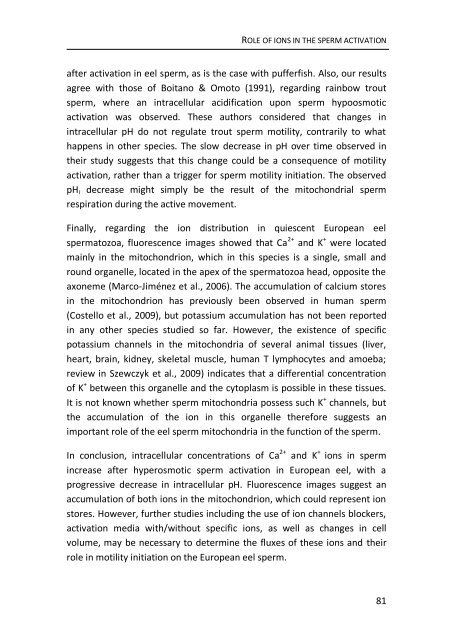chapter 3 - RiuNet
chapter 3 - RiuNet
chapter 3 - RiuNet
Create successful ePaper yourself
Turn your PDF publications into a flip-book with our unique Google optimized e-Paper software.
ROLE OF IONS IN THE SPERM ACTIVATION<br />
after activation in eel sperm, as is the case with pufferfish. Also, our results<br />
agree with those of Boitano & Omoto (1991), regarding rainbow trout<br />
sperm, where an intracellular acidification upon sperm hypoosmotic<br />
activation was observed. These authors considered that changes in<br />
intracellular pH do not regulate trout sperm motility, contrarily to what<br />
happens in other species. The slow decrease in pH over time observed in<br />
their study suggests that this change could be a consequence of motility<br />
activation, rather than a trigger for sperm motility initiation. The observed<br />
pH i decrease might simply be the result of the mitochondrial sperm<br />
respiration during the active movement.<br />
Finally, regarding the ion distribution in quiescent European eel<br />
spermatozoa, fluorescence images showed that Ca 2+ and K + were located<br />
mainly in the mitochondrion, which in this species is a single, small and<br />
round organelle, located in the apex of the spermatozoa head, opposite the<br />
axoneme (Marco-Jiménez et al., 2006). The accumulation of calcium stores<br />
in the mitochondrion has previously been observed in human sperm<br />
(Costello et al., 2009), but potassium accumulation has not been reported<br />
in any other species studied so far. However, the existence of specific<br />
potassium channels in the mitochondria of several animal tissues (liver,<br />
heart, brain, kidney, skeletal muscle, human T lymphocytes and amoeba;<br />
review in Szewczyk et al., 2009) indicates that a differential concentration<br />
of K + between this organelle and the cytoplasm is possible in these tissues.<br />
It is not known whether sperm mitochondria possess such K + channels, but<br />
the accumulation of the ion in this organelle therefore suggests an<br />
important role of the eel sperm mitochondria in the function of the sperm.<br />
In conclusion, intracellular concentrations of Ca 2+ and K + ions in sperm<br />
increase after hyperosmotic sperm activation in European eel, with a<br />
progressive decrease in intracellular pH. Fluorescence images suggest an<br />
accumulation of both ions in the mitochondrion, which could represent ion<br />
stores. However, further studies including the use of ion channels blockers,<br />
activation media with/without specific ions, as well as changes in cell<br />
volume, may be necessary to determine the fluxes of these ions and their<br />
role in motility initiation on the European eel sperm.<br />
81
















